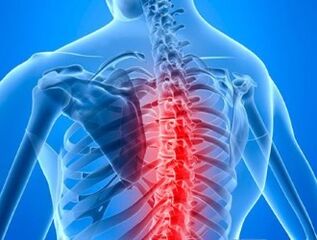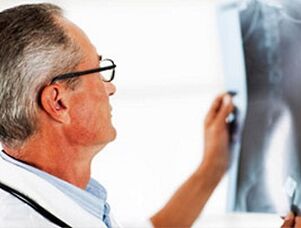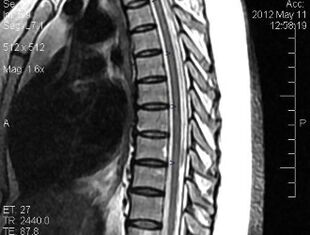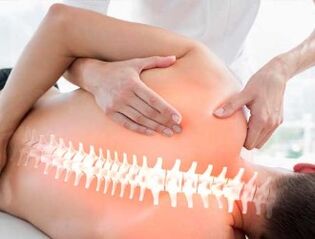
Osteochondrosisis a disease of modern society.
Hypodynamia, improper nutrition leads to pathological changes in the spine.
Thoracic osteochondrosis is much less common than cervical and lumbar osteochondrosis.
This is due to the reduced mobility of this part of the spine.
According to the International Classification of Diseases (ICD 10), the disease has the code M42.
Essence of Pathology
Osteochondrosis of the thoracic spine is dystrophic changes in the cartilage and bone tissues of the spine. The disease affects both sexes between the ages of 25 and 50. The insidiousness of the disease is that the symptoms are "masked" by signs of other diseases (cardiovascular or gastric), therefore, thoracic osteochondrosis is diagnosed too late.
Disease Development Algorithm:
- Under the influence of unfavorable factors, the nucleus of the spinal disc becomes thinner and flattened.
- The adjacent vertebrae approach each other, a focus of inflammation arises between them.
- The joint capsules are elongated, the mobility of the spine decreases.
- The roots of the spinal nerves are pinched.
- The spinal cord is compressed.
- The bone tissue of the vertebrae grows, bone processes (osteophytes) appear.
Four stages of the disease are distinguished according to the degree of vertebral injury:
| Phase 1 | Changes in the vertebrae are not expressed, there are no bright symptoms. At this stage, the treatment gives a good effect - it is possible to restore damaged tissue. |
| Phase 2 | This stage is characterized by the appearance of microcracks in the vertebrae, reduced mobility. The vertebrae begin to move relative to each other. The treatment takes a lot of time and effort. |
| Phase 3 | The vertebral discs become thinner to the point that protrusions and hernias appear. Mobility is reduced to a minimum. At this stage, the nerves are pinched, the work of the internal organs is disrupted. If you don't start treatment, this will lead to disability. |
| Phase 4 | There is a complete thinning of the discs, the function of the spine is impaired, the process of destruction of bone tissue is underway. Neurological symptoms are pronounced. |
Thoracic osteochondrosis has a wavy character, ie periods of remission and exacerbation alternate.
Reasons
So farthe exact causes of the disease have not been established. In medicine, there are many theories on this topic, but none of them provide an accurate explanation of why the spinal cartilage degeneration process begins. The main "culprit" is acknowledged to be walking upright.

The provoking factors are considered:
- Inheritance.
- Congenital malformations of the spine.
- Infectious diseases.
- Obesity.
- Hypodynamics.
- Long stay in one position.
- Unbalanced diet, lacking vitamins and minerals.
- Back injuries.
- Age-related changes.
- Great physical activity (during sports or related to work).
- Flat feet.
- Pregnancy.
- Prolonged stress.
- I smoke.
Consequences
Left untreated, the consequences of osteochondrosis can be catastrophic.Degenerative changes result in a herniated spine. Compression of the nervesleads to loss of sensation in the limbs. The most serious complication is paralysis of the arms or legs.
Also,interrupts the work of all internal organs and systems: cardiovascular, urinary, digestive. The patient develops vegetative-vascular dystonia. The fact is that the spinal vessels are compressed, the oxygen supply to the brain is interrupted. The patient experiences constant headaches, panic attacks, sleep disturbances. Intercostal neuralgia is also a consequence of osteochondrosis.
Symptoms
The first symptom of the disease isfeeling of tension in the back muscles. Then a dull pain in the back joins. Other manifestations may be similar to signs of other diseases, which is why thoracic osteochondrosis is called "chameleon".
The main symptoms of the disease are:
- "goosebumps";
- chest pain;
- shooting pain between the shoulder blades, especially when turning the body;
- dizziness;
- fainting;
- pressing pain in the heart region;
- swelling of the hands and feet;
- feeling of numbness in the hands;
- indigestion;
- decreased sexual function;
- acute short-term pain in the rib area;
- fatigue, reduced performance;
- general malaise.
Diagnostics
A doctor can make a diagnosis by carrying out a comprehensive examination.
It is important to differentiate osteochondrosis from other diseases of the skeletal system, such as:
- rheumatoid arthritis;
- ostiomyelitis;
- spondylopathy.

It is also important to exclude diseases of the internal organs:
- ischemia;
- heart attack;
- gastritis;
- stomach ulcer;
- pancreatitis;
- kidney stones;
- pyelonephritis;
- tumors.
Laboratory and instrumental methods are used for diagnostics:
- Blood test. There is a slight increase in leukocytes and ESR.
- Blood test for electrolytes. With osteochondrosis, the serum calcium level is reduced.
- General urine analysis.
- Biochemistry of blood.
- X-ray of the spine. It allows you to detect the deformation of the discs, the displacement of the vertebrae, the presence of a hernia.
- MRI. With the help of layer-by-layer images, the degree of degenerative changes in the spine is specified.
- Myelography. This is an X-ray examination of the spine using contrast. Allows you to assess the state of blood flow in the vessels of the spine.
Treatment
Treatment of the disease is carried out on an outpatient basis. For this, conservative methods are used.Therapy is aimed at:
- pain relief;
- reduction of inflammation;
- elimination of compression of nerve endings;
- restoration of cartilage tissue.
If the patient is in severe pain, bed rest should be ensured. With severe pain syndrome, novocaine blockade is performed. At the same time, droppers are placed with non-steroidal anti-inflammatory drugs.
Methods of treating osteochondrosis
Drugs include the following drugs:
| Non-steroidal anti-inflammatory drugs | Depending on the severity, the products can be injected, pills or ointments. |
| Painkillers | - |
| Muscle relaxants | To be used in case of spasm of the back muscles. |
| Chondroprotector | Restores cartilage tissue. |
| Diuretics | Reduce edema. |
| Vitamins of group B | For general strengthening of the back muscles, spine and central nervous system |
At 3 and 4 stages of the disease, the therapy is more serious. Hormonal drugs are prescribed.
Massageincreases the tone of the back muscles, relieves pain.The following types of massage are used:
- classic;
- dotted;
- in box.
Physiotherapyis prescribed in the remission phase, performed under the supervision of a specialist. Exercises are aimed at strengthening the muscular corset, increasing the mobility of the spine and relieving the compression of the nerve roots. The patient's metabolism improves.

Physiotherapyhas a good therapeutic effect, especially at 1-2 stages. It is recommended to conduct several courses a year to prevent exacerbation. They use magnetotherapy, laser exposure, ultrasound, electrophoresis.
Manual therapyis an irreplaceable method for the treatment of osteochondrosis. Blood circulation is restored, the nutrition of the spinal tissues improves. The qualifications of a specialist are of great importance.
Spinal tractionis a controversial method. Some doctors believe that this, on the contrary, aggravates the patient's condition. The essence of traction is to increase the intervertebral space using special equipment. In any case, this method must be used with caution.
Acupuncture. The impact on the active points not only relieves pain, but also rebalances the patient's psyche.
Follow a special diet. It assumes a decrease in the diet of animal fats, an increase in the amount of plant foods. Nutrition should be balanced to provide the body with vitamins and minerals.
The effect of the therapy is achieved by combining different treatments. Surgical treatment is extremely rare if there is no effect of conservative treatment.
Prediction and prevention
The prognosis of the disease depends on the degree of spinal injury.It is impossible to completely cure the disease in 2-4 stages. Properly selected therapy can only relieve inflammation and stop the progression of the disease. With proper treatment, the stage of remission is reached, which must be maintained with preventive methods.
The prevention of osteochondrosis is:
- maintain a healthy lifestyle;
- respect for proper nutrition;
- exclusion of excessive physical exertion;
- avoid being in one position for a long time;
- weight loss;
- timely treatment of infectious diseases.
Conclusion
Osteochondrosis of the thoracic regionis a serious disease that "ages" every year. Due to the less mobility of this spine in the initial stage, the disease does not manifest itself.
Symptoms are not specific, so other pathologies of internal organs are suspected. It is important to make a differential diagnosis to make an accurate diagnosis and prescribe adequate treatment.
The disease is treated using conservative methods, used in combination. Surgery is extremely rare if severe complications occur. In the absence of proper treatment, the patient's internal organs are disrupted and the quality of life is deteriorating significantly.
Negative consequences can be avoided with the help of correctly selected therapy and adherence to preventive measures.


















































